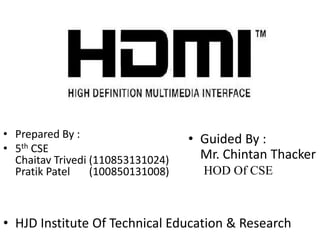Hdmi
- 1. • Prepared By : • Guided By : • 5th CSE Chaitav Trivedi (110853131024) Mr. Chintan Thacker Pratik Patel (100850131008) HOD Of CSE • HJD Institute Of Technical Education & Research
- 2. Outline • Objective • Introduction • Methodology • Implementation Detail • Result Analysis
- 3. Objective • HDMI is the first & only industry supported, uncompressed, all-digital audio/video interface,HDMI supports standard high-definition video, plus multi- channel digital audio on a single cable.
- 4. Introduction • HDMI (High Definition Multimedia Interface) • HDMI v1.3 vs. existing technologies such as S video and DVI. • Active devices that are available to facilitate and distribute HDMI. • Opportunities for HDMI
- 8. HDMI over existing analog interfaces • Because HDMI is a digital interface, it provides the best quality of the video • HDMI cables are more likely to be successful at carrying large amounts of data longer distances • Single cable for both video and audio is the most effective format ! • The cable carries full digital audio and video at high resolutions between source, receiver and display.
- 10. The Cable • TMDS - Transition Minimized Differential Signaling – refers to the high speed signal data, audio and video are multiplexed, eliminating the need for audio channels • DDC - Display Data Channel – is a digital connection between a display and a graphics adapter that allows the display to communicate its specifications to the adapter – supply channel, provides power to DDC whether on/off – simply put plug and play • CEC- Consumer Electronics Control – industry standard protocol, is used for remote control functions, universal remote
- 14. HDMI FEATURES • Bandwidth more than doubled from 165 MHz (4.95 Gbps) to 340 MHz (10.2 Gbps) to support Higher Resolution, and Deep Color. • HDMI is a conduit or pipe that moves data. • With more bandwidth we have more room for more goodies today and in the future. • Backward compatible with legacy versions.
- 15. HDMI 1.0/1.2 Versus 1.3
- 16. Deep Color • Deep Color increases the number of bits available for transmission for each channel. • So, for example, a TV that accepts the 24 or 12-bit form can mix together any one of 4,096 shades (levels of brightness) of each primary color for 68.7 billion possible colors. 4,096 red x 4,096 green x 4,096 blue = 68,719,476,736 colors!!
- 17. HDMI Problems Areas • Manufacturing, non-approved HDMI cables can produce poor results. • Poor installation, long cable runs, improper active devices, lack of knowledge. • Cost of cable is much higher compare to others.
- 18. What is HDCP? • High-bandwidth Digital Content Protection encrypts data over HDMI. • HDCP helps bring high-definition digital content to consumers by providing copy protection over HDMI
- 19. How it works
- 20. HDMI Opportunities • HDMI is growing with the advancement of high definition programming and DVDs. • Video Games and PC are also integrating HDMI for optimization of their products. • Commercially companies are choosing HDMI, sports and entertainment, video displays, airports, restaurants the list goes on.
- 21. Commercial • Implementation in commercial buildings i.e: – offices, – airport terminals – restaurants. • Less set top boxes due to extenders and HDMI active devices. • Perfect for new builds using cat5e cable to extend your HDMI signal.
- 22. Result of HDMI • Current world: limited to 24 bits/ pixel color - 16 million colors • Deep Color allows 24, 30, 36 and 48 bits/pixel color depth Billions of colors • Increases contrast ratios for sharper images & greater detail • More accurately represents original material
- 23. Typical HDMI Set Up
- 24. Conclusion • For High definition multimedia it is very useful as an interface without any quality degradation .
- 25. References • http://electronics.howstuffworks.com/hdmi.h tm • www.Wikipedia.org • www.hdmi.org
- 26. Thank You


























